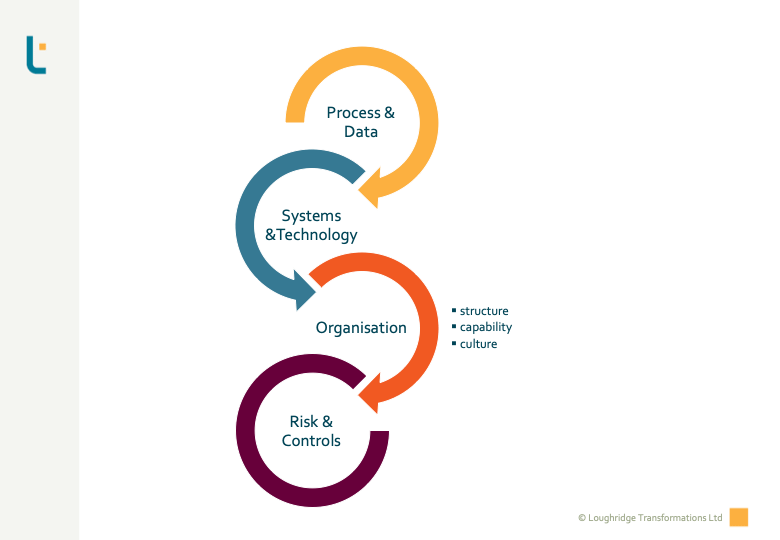Digital Financial Closing – Four Critical Steps. Technology is not the Saviour!

AUTHOR: KNUT HAUGLAND
SENIOR ASSOCIATE CONSULTANT
Knut is a Senior Finance professional with 19+ years of global experience. He specialises in Finance Transformation and Internal Audit, with particular expertise in Risk & Financial Controls, Process Design & Deploy, Shared-Service Set-Up and Migrations.
knut.haugland@loughridgetransformations.com
Why Consider a Digital Financial Closing?
As Digital Transformation takes on ever-increasing importance, only accelerated due to the COVID-19 pandemic, let’s look at the financial closing and the opportunity for increased digital transformation.
Finance professionals often see the closing as painful. It is associated with long hours, weekend-working, endless adjustment journals compensating for an inadequate or not fit-for-purpose ERP set-up, or error-prone masterdata – to mention a few of the difficulties.
These can result in labour-intensive, manual workarounds, excessive spreadsheet use, reconciliation issues, problems producing accurate, usable Management Information, and more!
Opportunities for Automation
Digital Transformation or Automation can significantly reduce or even eliminate the pain points and labour intensity of a financial closing. Opportunities exist for the automation of process steps, such as:
- running ERP transactions and programmes
- workflow approvals
- consolidation of a multi-company set-up
- account reconciliations
Here are three forms of possible automation:

Robotic and intelligent automation solutions are the most readily applicable in the financial closing process.
Is Software the Answer?
You may have searched the internet for the topic. In that case, you will have found a wealth of companies offering various software solutions enabling your organisation to increase the automation of Finance processes.
When looking at the ocean of software solutions on offer, it often appears like a straightforward and cost-efficient exercise. The return on investment promised is undoubtedly appealing. However, the challenge is not usually in the technology itself. In fact, from our analysis, different solutions often offer similar functionality. Selecting a solution often comes down to organisational preference and fit. It is, however, worth emphasising that the implementation is not as easy and quick as the advertisements and sales pitches might have you believe.
Pre-Requisites for the Digital Financial Closing
In terms of time and money invested in the automation of the Financial Closing process, we would argue that you should budget far more for the “prepare-for-automation” phase and the organisational readiness phase than the actual cost of the software IT infrastructure. Whereas the software cost is mainly fixed, the preparation and readiness phases and their associated costs can vary from organisation to organisation. It depends on the circumstance, size and complexity of the organisation.

Process
Finance processes are often run via institutional memory rather than clear and specific protocols. The various people involved “just know how things get done.” A lack of standardised and documented procedures and routines hinders efficient automation. The more multi-national the organisation is, the bigger the problem becomes. We often see a loose list of month-end tasks in spreadsheets – usually not shared or visible across geographies or divisions. When and whether the tasks get completed each month is often anyone’s guess. However, technology helps, and documentation and task-tracking are critical to capture real efficiency gains in the closing process. It is almost impossible to automate processes without clearly understanding the dependencies and task durations. Assess each task in the close process as to its value and reason.
Data
To start, think about how you are managing the masterdata. By masterdata, we mean a harmonised chart of accounts, reporting entities, cost and profit centres, industry and company attributes, and so on. Let’s imagine you have automated your ERP programmes/transaction codes (for example, cost allocation, depreciation, and so on). However, if your masterdata quality is low, the ERP programme will likely halt due to errors. A resolution will require manual intervention. It is somewhat like having a hi-tec remote control starter for your car while having some underlying problems with the engine. It results in your car breaking down a mile along the road every time you set out. If some fundamentals are missing, what have you gained?
Organisation
Once the process understanding is as above, it is much easier to get a good overview of the people involved, specifically the process operators. Before Transformation (digital or otherwise), most staff working on the closing will spend their time in one or more of the following:
- Generating or Inputting data;
- Finding problems; and
- Implementing workarounds
The critical organisational pre-requisite is to get the organisation to develop or improve a process mindset. That means defining standard ways of working; and, instead of solving problems by workarounds, enhancing the underlying process. Our blog on Sustain the Change addresses this in more detail. Post-transformation, you will typically find that finance staff monitor and supervise processes and validate system activities. This shift needs to be prepared for via new role definition and training as part of the deployment. We cover this in our blog on Getting Your Finance Organisation Ready for Digital Transformation.
Controls
For those experienced control operators, there is no need to explain how time-consuming this task can be – even more so when operating manual controls. Typically, you find such controls within the:
- reconciliations of accounts
- between ledgers
- Excel-driven calculations
- and on and on!
Many manual controls become redundant in a system-driven, automated closing process as system controls supersede them. In addition, system controls give more robust assurance, as they do not rely on judgment and discretion in the control execution. Lastly, system controls do not require frequent Operational Effectiveness testing. An annual IT test is typically sufficient to ensure the system software “does what it says on the tin”.
Waterfall or Agile Delivery?
The good news is that not all pre-requisites need to be completed before any automation deployment. The deployment can be concurrent, piece-by-piece, or in whatever way and at whatever pace suits your organisation best. You can, for example, implement quick wins and simultaneously work on medium- and longer-term solutions. Whatever you decide, make sure you have analysed your AS-IS situation correctly.
Such AS-IS analysis should result in a detailed description of your pain points. It could, for example, be inaccurate data caused by excessive use of spreadsheets leading to error fixing and re-work. Perhaps, reporting functionality is poor as useful Management Information cannot be extracted directly from your system but has to be re-worked via spreadsheets. That, in turn, leads to a heavy workload for staff resulting in overtime and little time for value-add analysis. Whatever your issue within your closing process, it is crucial to understand what you are trying to solve. Our Loughridge Transformations‘ “Nine Steps” method is invaluable in that analysis.
Digital Financial Closing – Practical Examples:
For simplicity, let’s say your financial close starts on the last workday of the month, WD-1, and ends with reporting your monthly, quarterly, or annual results on WD+10. This schedule is often your organisation’s critical path in the financial closing. Each day will have specific tasks with deadlines. A delay on any particular day will impact the subsequent tasks and activities. The aim is to analyse if you can remove items from the critical path – even more so for those time-consuming activities.
Running depreciation is a good example. Many companies have successfully removed the fixed assets depreciation activities from the critical path by running them one month in arrears. Naturally, that needs an agreement with the external auditors. However, the impact is that you can run depreciation on, say, WD-5, which gives you plenty of time to resolve any errors in advance of the critical path.
Reconciliations are another example. Moving to a weekly reconciliation cycle means there will only be one week’s worth of transactions to reconcile rather than one month’s worth. Next, consider if your organisation struggles with many accounts. You could identify a much smaller set of accounts as critical. Only these accounts are then subject to reconciliation during the critical path. The team can reconcile all other accounts outside of the closing period.
Which Tasks are Best-Suited for Automation?
The simple answer is that any job in your closing process, which utilises your ERP, is suitable for automation. However, before you automate the task (ERP transaction code) – you should be comfortable that the transaction usually runs smoothly. Suppose, for example, that you are consistently experiencing ERP jobs that fail, such as postings to closed cost centres, and, consequently, need manual intervention. There is little point in automation in that case, as the job will still not complete correctly. You will likely require a more permanent fix before automating the transaction. This example reiterates the importance of your organisation’s “readiness-for-automation” phase before embarking on the automation journey within your closing process.
In summary, we fully endorse any ambition to automate – however, don’t make the mistake of relying on software to fix underlying problems – that being clean-up of process, masterdata or human behavioural aspects.
How can Loughridge Transformations support your Digital Financial Closing?
As a process-led, people-led Finance Transformation practice, people are always at the core of our design solutions. Loughridge Transformations focus on organisational structure, capability and culture while ensuring process design reflects the latest digital developments. We provide successful and sustainable delivery through the Loughridge Transformations’ Nine Steps to Finance Transformation.
Loughridge Transformations can offer – with no further obligations – short virtual workshops that your organisation can use as the first building block in Finance digital transformation.
Find Out More About Working with Loughridge Transformations
Get the Latest from Loughridge Transformations
Subscribe to Our Blog
Alternatively, take a look at our most popular blog posts:
Looking for something else? Here’s what we have been blogging about recently:
Agile Analytics Associates Automation Behaviours Building Trust Business-Partnering CFO Remit Change Management Coaching Collaboration Continuous Improvement Control Design Corporate Governance Data Deployment Design Principles Digital ERP ESG Finance Function Finance Transformation Implementation Migration Off-Shoring Organisation Organisation Design Process Process Design Process Governance Process Performance Productivity Programme Management Office Project Management Readiness Risk & Controls Skills sponsorship Standard Organisational Model Strategy Systems Systems Design Technology Transformation Virtual Working


